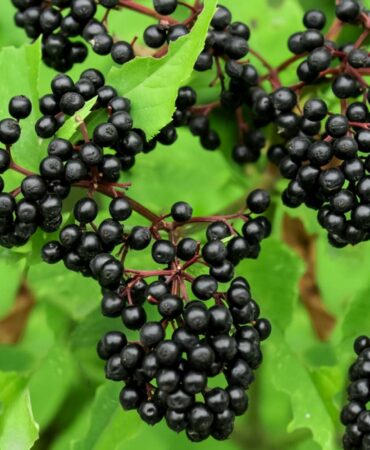Currently Empty: £0.00

Herb Histories: Elderberries – Magic, Music and Medicine
For this weekend-read we’re siting down and fastening our seat belts as Helen takes us on a fast paced tour of the history of the Elder tree, its uses, names and origins. You’re likely familiar with the tree as it’s a staple of the British landscape (as well as many others worldwide) and if you’re partial to an elderflower cordial (or gin) then you’ll have partaken in one of the most popular uses of its blossom. In this first chapter of our new monthly series, Herb Histories, we’re looking particularly at the fruit of the Elder tree, the Elderberries, which are ripening as we speak – well read. Get your cuppa ready and settle down as Herb Histories with Helen begins…
Written by Helen Miller
Magic, Music and Medicine
The Elder tree has long been associated with magic and mystery. Much of these associations go back to before Roman times, implying that the Celts, Anglo-Saxons and Vikings were knowledgeable about the medicinal uses of this tree. It is known to have been used as food by Neolithic people and used for medicine by the Ancient Egyptians. 2
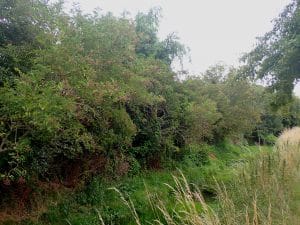
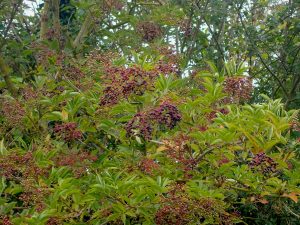
What’s In A Name?
Hylder, Hylantree, Eldrum, Ellhorn, Hollunder, Sureau, Pipe Tree, Bore Tree, Bour Tree, Black Elder, Common Elder – all are different ways people have referred to the Elder tree! 2, 6
The word Elder itself comes from ‘aeld’ the Anglo-Saxon for fire. This comes from the use of the young hollow branches for starting fires. The names Pipe Tree and Bore Tree come from the practice of making hollow tubes from the branches by pushing out the soft pith.6
In England, the plant referred to as Elder in herbal books is not always the same plant that we know as the Elder tree today. The Old English name for Elder was ‘ellen’. In the tenth century ‘ellenwyrt’ was a commonly used plant but it has been suggested that this may actually be a reference to Elecampane, not Elder.10
Ellenrind refers to the bark of the Elder tree and was used for inflammation in a mixture with iris, feverfew, garlic, radish, cress, nettle, pepper, watermint and malt-ale. Another use given in a 10th century Leechbook is ‘For the enlarged body…’ (thought to be elephantiasis) and used Dwarf Elder twigs as part of a bath mixture.10
People often think that names are fairly consistent but they change as languages change. Before the use of scientific names, people from different places called the same plant different names – the name of a single plant could vary within and between countries. This makes tracking a plant and its uses back through time tricky!
The use of Elder in music gives the tree its scientific name – Sambucus nigra. Sambuca was the Greek name for the ancient musical instrument known as a Sabuc.3 Presumably the instrument was made from the wood of the Elder tree, but the Sambuca was a stringed instrument, not a pipe-based one so this link may be tenuous. Until recently, a simple pipe instrument called a ‘sampogna’ was made from the branches of Elder by Italians.6
Myth and Magic
Throughout history people seem to have viewed Elder with caution and there is a lot of folklore and superstition associated with the Elder tree. 2,6
In Denmark, it was thought that a dryad lived in the Elder tree and watched over it. She was known as the Hylde-Moer, or Elder-tree Mother, and if anyone cut down her tree she would follow the wood – her property – and haunt the owners of whatever was made from it. Putting a child in an Elder cradle therefore, was thought to be as good as giving the child to the fairies. This is why people believed it was important to ask before taking anything from an Elder tree. Silence after the request was made meant that permission had been given. 2,6
Not all countries viewed the Elder with suspicion. Early folk-lore says the Elder tree gave protection from witches, Russians believe it gives protection from evil spirits and people from the Bohemia region of the Czech Republic believed that it can be used to make a spell to take away fevers. In England it was believed that if an Elder twig was tied in three or four knots and carried with a person it would act as a charm to drive away rheumatism.6 People gave the Elder enormous respect because they ‘…could always rely upon its invaluable help in times of emergency’.7
Fruits of Favour
Elderberries themselves have been used in herbal remedies for a very long time as recorded in ‘The Anatomy of Elder’ by Dr Martin Blochwich, published in 1644.3 This book gives one of the earliest accounts for uses of Elderberry7, which are commonly harvested between August and September in Great Britain.2
A lot of attention is given to the bark, roots, leaves and flowers in earlier herbals, but less to the fruits. Hildegard von Bingen, however, wrote in her ‘Physica’ (written between 1151 and 1158 AD) that Elder, or holderbaum, ‘…is of little value for human use, except its fruit does serve the human being’.11 This sounds odd given the wide range of uses that the flowers, berries, leaves and bark seem to have been put to in more recent accounts.
In ‘The Anatomy of the Elder’ (translated from the original Latin by C. de Iryngio, a Scottish Medical Army Officer) the medicinal uses of the flowers, berries, pith, bark and roots are given. Another book of the time, ‘The Natural History of Coffee’ published in 1682, explores how Elder and Juniper berries could be used in coffee houses.
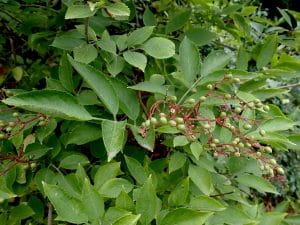
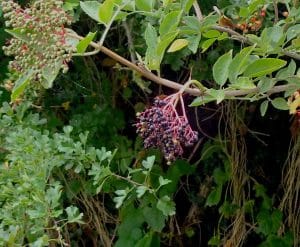
Traditional Uses of Elderberries
An Elderberry ‘Rob’ (vegetable juice thickened by heat and turned into a syrup) has been used for a long time to treat coughs and colds and is still widely used this way in France and Holland.2 However, some of the other past uses for Elderberries may be surprising, or possibly horrifying in places! These uses for the Rob include epilepsy in adults and children (the mother would drink the Rob and the children gained its benefits through the breastmilk), disinfectant in the time of the plague and generally as a sudorific (induces sweating). Taking the Rob to induce sweating was given as the best treatment for Simple Herpes in The Anatomy of Elder.3
The wine made from the berries was used to treat catarrh and arthritis. Oil from the kernels of the berries was used for blemishes and ulcers of the head and the purified oil was used as an emetic (to induce vomiting) or as a cathartic (to express repressed emotions). Elder vinegar in a hollow globe of juniper wood was carried as protection from the Plague. Essence of the berries was used to treat hysteria. Mouth ulcers caused by the Great Pox (Syphilis) were treated by rubbing them 2-3 times a day with spirit of Elderberries.3
Blending Elderberries with other herbs was also used to make medicines. A tasty sounding syrup for feverish infections was made from Elderberry juice and Violets. To treat a palsy of the limbs or side Elderberry Rob was combined with Antimony and Greater Burdock. Combining the pith and berries of Elder with Juniper berries and Liquorice was used to treat bladder stones, and blending lily, rose and elderberry waters was used to treat deliria or sleeplessness.3
Later, in 1653 with the publication of The Complete Herbal, Culpepper describes how ‘…berries boiled in wine…and the hair of the head washed therewith is made black.’ He also says the Rob is used for feverish colds and ‘…the juice of the berries boiled with honey and dropped into the ears helps the pains of them; the decoction of the berries in wine being drunk, provokes urine.’ 4
Modern Uses of Elderberries
Skipping forward a few centuries, the use of Elderberry, after the World Wars and with the introduction of the NHS, decreased. Today Elderberry is classed as a diaphoretic (induces perspiration), and aperient (relieves constipation) but normalises the bowel for diarrhoea. 2 Recently, however, there has been renewed interest in the use of Elderberry for the treatment of influenza.
A research paper published in 2019 found that Elderberries when used for the treatment of influenza exhibited potent antiviral activity and could reduce the entry of the virus into the cells of the body and the transmission of the virus from cell to cell. As well as this the Elderberries also modulate the cytokine (inflammatory) response of the body.12 This means the berries can increase or decrease the level of cytokines in a person depending on the situation. 1,5,8 This provides some support for the traditional, long-time, use of Elderberry in treating feverish colds.
Research into the components found in Elderberries has shown that they are extremely nutritious and have many bioactive compounds, such as anthocyanins, which also make them anti-oxidant. This adds to their anti-viral properties, and possibly gives Elder anti-depressant and anti-tumour affects. Further research is needed on these properties but there is an increasing amount of evidence that Elderberries can be a beneficial part of a healthy diet for everyone. 9 Although this may possibly not be news to the average Medieval person!
Herb Histories is a new blog series that will be published every third Saturday of every month up until the end of the year. If you would like to be notified directly via email when the next chapter is available please contact Ghislaine at blog@herbsociety.org.uk.
References
- Barak, V., T. Halperin, and I. Kalickman. “The Effect of Sambucol, a Black Elderberry-Based, Natural Product, on the Production of Human Cytokines: I. Inflammatory Cytokines.” European Cytokine Network 12, no. 2 (June 2001): 290–96.
- Barker, J. (2001) The Medicinal Flora of Britain and Northwestern Europe, Winter Press
- Blochwich, M. (1644) The Anatomy of Elder
- Culpepper, N. (1653) Culpepper’s Complete Herbal: consisting of a comprehensive description of nearly all herbs with their medicinal properties and directions for compounding the medicines extracted from them, W. Foulsham & Co., Ltd., London.
- de la Foret, R. (2020) Elderberry Side Effects https://www.herbalremediesadvice.org/elderberry-side-effects.html#Citations
- Grieves, M. (1998) A Modern Herbal, Tiger Books International, London.
- Jacobs (2010) Ed of The Anatomy of Elder, ebook, www.publishgreen.com.
- Kirichenko, Tatiana V., Igor A. Sobenin, Dragana Nikolic, Manfredi Rizzo, and Alexander N. Orekhov. “Anti-Cytokine Therapy for Prevention of Atherosclerosis.” Phytomedicine: International Journal of Phytotherapy and Phytopharmacology 23, no. 11 (October 15, 2016): 1198–1210. https://doi.org/10.1016/j.phymed.2015.12.002.
- Mlynarczyk, M., Walkowiak-Tomczak, D. and Lysiak, G. P. (2018) Bioactive properties of Sambucus nigra as a functional ingredient for food and pharmaceutical industry, Journal of Functional Foods, 40:377-390.
- Pollington, S. (2011) Leechbook: Early English charms, plantlore and healing, Anglo-Saxon Books
- Throop, P. (1998) Hildegard von Bingen’s Physica: The complete English translation of her classic work on health and healing, Healing Arts Press, Inner Traditions International, Vermont.
- Torabian, G., Valtchev, P., Adil, Q. and Dehghani. F. (2019) Anti-influenza activity of Elderberry (Sambucus nigra), Journal of Functional Foods, 54:353-360.

